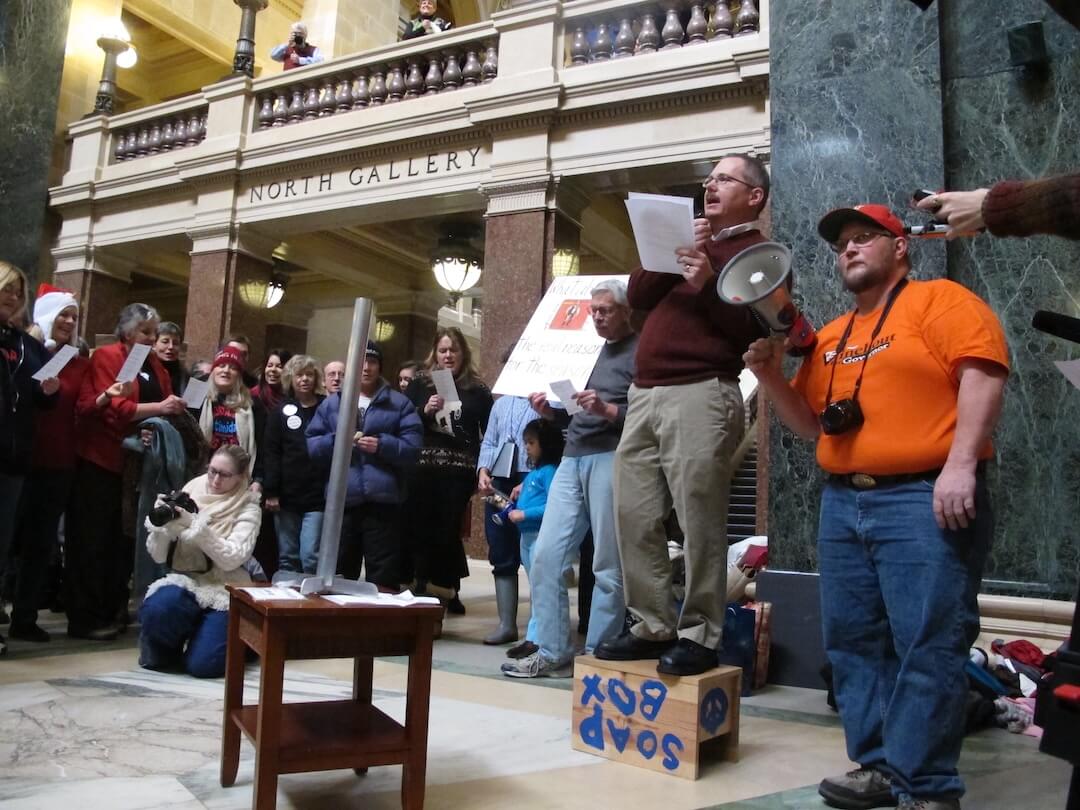A couple Fridays ago, Riverfront Times Editor Chad Garrison left his office with a cover story laid out and ready for proofreading.
But over the weekend, things changed. On Saturday, an unarmed teenager named Michael Brown was shot to death by a police officer in Ferguson, a suburb of St. Louis 22 minutes from the Riverfront Times’ office. The next day, looting began.
On Monday, Garrison had to decide whether to keep the story they’d laid out before the weekend — an evergreen investigative piece, he said — or tear up the paper and scramble to put together a new cover story about Michael Brown’s death.
“I think we’d have looked foolish if we’d have came out with the cover story that had nothing to do with the coverage here,” Garrison said.
He decided to scrap the first cover. Monday the staff continued to report and file dispatches about Ferguson. On Tuesday, they pieced together a narrative built from online reports from the embattled suburb. The resulting cover story, “Standoff in Ferguson: 72 hours of grief and anger in the wake of a controversial killing” featured an interview with Brown’s family, firsthand accounts of looted storefronts and eyewitness testimony of tear gas being deployed.
The Riverfront Times’ coverage started with Managing Editor Jessica Lussenhop, who was eating dinner with a friend Saturday night when she received word of the shooting. She drove to Ferguson on Sunday and scored one of first interviews with Brown’s family. Later that night, Daniel Hill, the paper’s music editor, and Danny Wicentowski, a staff writer, both decided to cover Ferguson independently and bumped into each other in a parking lot.
Crowds gathering at site of #michaelbrown shooting. pic.twitter.com/QuxP3Dk3jX
— Jessica Lussenhop (@Lussenpop) August 10, 2014
The paper’s news blog, which typically gets between 150,000 to 200,000 pageviews per week, had already received 700,000 views by Friday. The paper’s staff has also seen its engagement on Twitter skyrocket while they live-tweeted from Ferguson during the protest. Ray Downs, a staff writer for the Riverfront Times, received more than 4,000 mentions for a tweet quoting a police officer who told him to “get back there with the real media.”
2/2) “Get back there with the ‘real’ media. And get that camera out of my face, slick. I can give you a problem.” — Ray Downs (@RayDowns) August 14, 2014
Wicentowski also saw his mentions increase nearly every day while he tweeted from Ferguson — his most-shared tweet garnered 2,500 mentions, according to a Topsy analysis.  The episode has exhausted the reporters, many of whom worked long hours with little sleep in between. Lindsay Toler, a news blogger, was halfway through a bottle of Busch at a cash-only dive bar on Sunday when she saw TV reports of the chaos in Ferguson. She left without saying a word to her friends and spent the rest of the night monitoring the story on Twitter. She estimates she has worked several 12-hour days since then, with about five hours of sleep daily. Lussenhop said she and her fellow journalists are running on about three to five hours of sleep most days. Garrison tried to convince his reporters to take a break, but they resisted. On Thursday, he edited a story from a wiped-out reporter who spelled “Ferguson” four different ways.
The episode has exhausted the reporters, many of whom worked long hours with little sleep in between. Lindsay Toler, a news blogger, was halfway through a bottle of Busch at a cash-only dive bar on Sunday when she saw TV reports of the chaos in Ferguson. She left without saying a word to her friends and spent the rest of the night monitoring the story on Twitter. She estimates she has worked several 12-hour days since then, with about five hours of sleep daily. Lussenhop said she and her fellow journalists are running on about three to five hours of sleep most days. Garrison tried to convince his reporters to take a break, but they resisted. On Thursday, he edited a story from a wiped-out reporter who spelled “Ferguson” four different ways.
“If this continues to go on for several more days, then people are going to be exhausted, and we don’t have new recruits to step into the void,” Garrison said on Thursday.
Since then, the protests have continued late into the night, with several reporters being detained briefly on Sunday night and police continuing to deploy tear gas. This Monday, he had a mandatory staff meeting, where it was decided only one reporter would go out to Ferguson nightly.
Because of the scope of the story, the paper has devoted most of its small editorial staff to covering Ferguson. Of the 39 stories published on the paper’s news blog last week, 34 of them were about the suburb. The other five were written before the shooting. Hill has pitched in, filing a report about police use of force and a humorous piece about locking his keys in his car near the police line. He also wrote an analysis of Brown’s rap lyrics. The three daily reporters in the “newsroom” (Garrison says he uses that term in air quotes because of the tiny staff) have been reporting from the scene or promoting the paper’s work online.
Because it’s stretched so thin, the staff is using its scarce resources to provide coverage other news organizations aren’t, rather than retread everyone else’s work, Toler said. Now that press conferences are being televised by national media, the staff sometimes opts out of attending them, reporting them from telecasts instead. They’ve also tried to focus on human interest stories that weren’t being told — the armed store owners who stood watch over a tattoo parlor, a man who protested Brown’s killing from horseback, New Black Panther Party members who said they were trying to promote peace.
“We’re trying to do something in between there, and we’re the only ones that have been able to find them and tell these stories that have some of the irreverence and quirk that the legacy media don’t have,” Toler said.
Lussenhop said covering Ferguson has brought the staff closer together than it’s ever been before. They’re motivated by a desire to explain how this “singular moment” in the history of St. Louis is affecting its citizens, she said.
“I think alt-weeklies are all about telling the stories of American cities,” she said. “And this is an important moment in an American city.”
Correction: I misheard Garrison when I interviewed him; he said “air quotes,” not “scare quotes.”








Comments